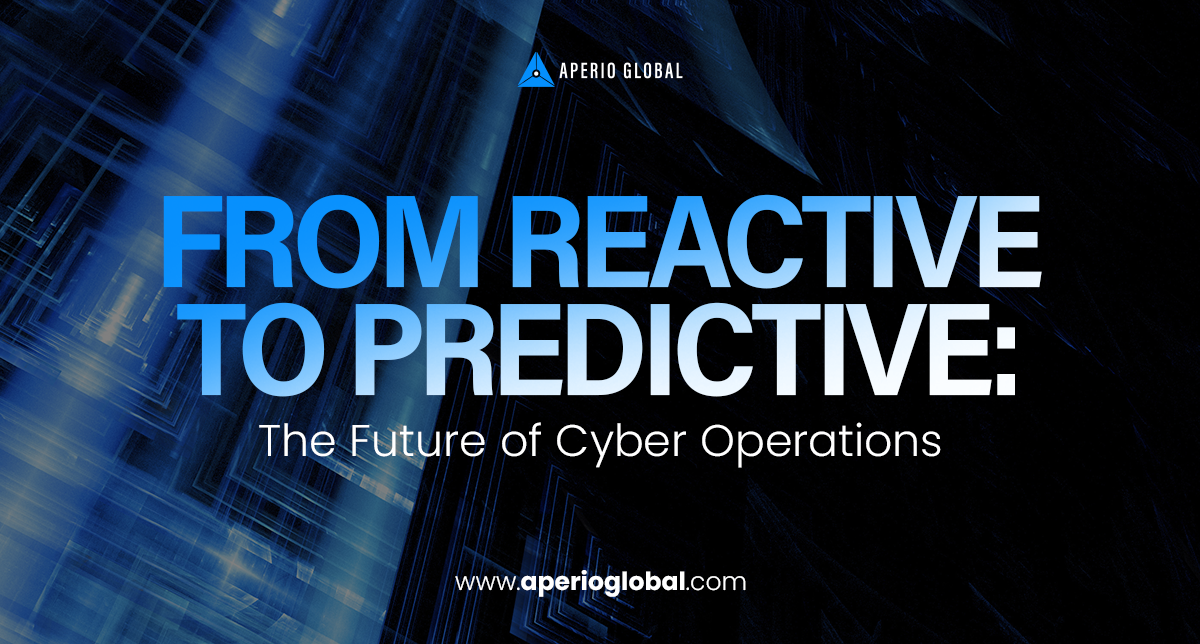
How AI-driven intelligence is transforming cybersecurity from response to foresight
For decades, cybersecurity has operated like an emergency room, responding to breaches after the damage is done. Alerts pour in, analysts triage incidents, and teams work tirelessly to contain what they can see. But in today’s threat landscape, reaction is no longer enough. The speed, scale, and sophistication of attacks demand a new paradigm, one that replaces defense through detection with defense through anticipation.
Cybersecurity is evolving into a field of intelligence, not just protection. This evolution is powered by artificial intelligence, advanced data fusion, and contextual analytics—technologies that transform raw signals into meaningful foresight. At Aperio Global, we see this as the defining shift of our time: from managing cyber events to predicting and preventing them.
Reactive systems, by nature, are limited. They depend on known signatures, predefined rules, and historic behaviors. The result is a constant game of catch-up, chasing yesterday’s tactics while adversaries innovate in real time. Predictive cyber operations turn that equation upside down. By using machine learning and de-biased data models, organizations can identify subtle anomalies before they become incidents, uncover threat vectors before they are weaponized, and recognize behavioral deviations that no static rule set could detect.
But predictive capability doesn’t come from automation alone. It comes from intelligence-driven design—a disciplined integration of context, human expertise, and AI. The key is not simply collecting more data; it’s interpreting data differently. Every packet, log, or sensor output is a fragment of a larger narrative. When these fragments are connected through transparent AI systems, patterns begin to emerge, revealing intent, not just activity.
Aperio’s approach to cyber operations begins here: with clarity. We engineer platforms that combine de-biased data processing with explainable AI, giving analysts the ability to see why a system predicts what it does. That “why” is crucial. It allows defenders to move beyond blind alerts and toward informed anticipation. When cyber teams understand the reasoning behind a model’s forecast, they can validate it, refine it, and respond with precision rather than panic.
This predictive posture has transformative implications. It shortens response times, reduces false positives, and strengthens resilience across the enterprise. More importantly, it shifts cybersecurity from a technical function to a strategic capability—one that informs leadership decisions at the operational and national level. In environments where milliseconds matter, foresight becomes a form of power.
The path forward also requires a change in culture. Organizations must evolve from measuring cyber success by “incidents contained” to measuring it by “incidents prevented.” That means fostering collaboration between human analysts and intelligent systems—a partnership where each strengthens the other. AI offers speed, scale, and pattern recognition; humans contribute judgment, ethics, and adaptability. Together, they create a defense posture that is not only stronger but smarter.
The future of cyber operations is predictive, adaptive, and transparent. It’s built on systems that think ahead, data that tells the truth, and analysts who understand the intelligence behind the automation. At Aperio Global, we believe this is not an abstract vision—it’s an operational necessity.
In a world where threats evolve by the second, preparedness cannot wait for proof of attack. The most secure organizations won’t be those that react fastest—they’ll be the ones that see it coming first.